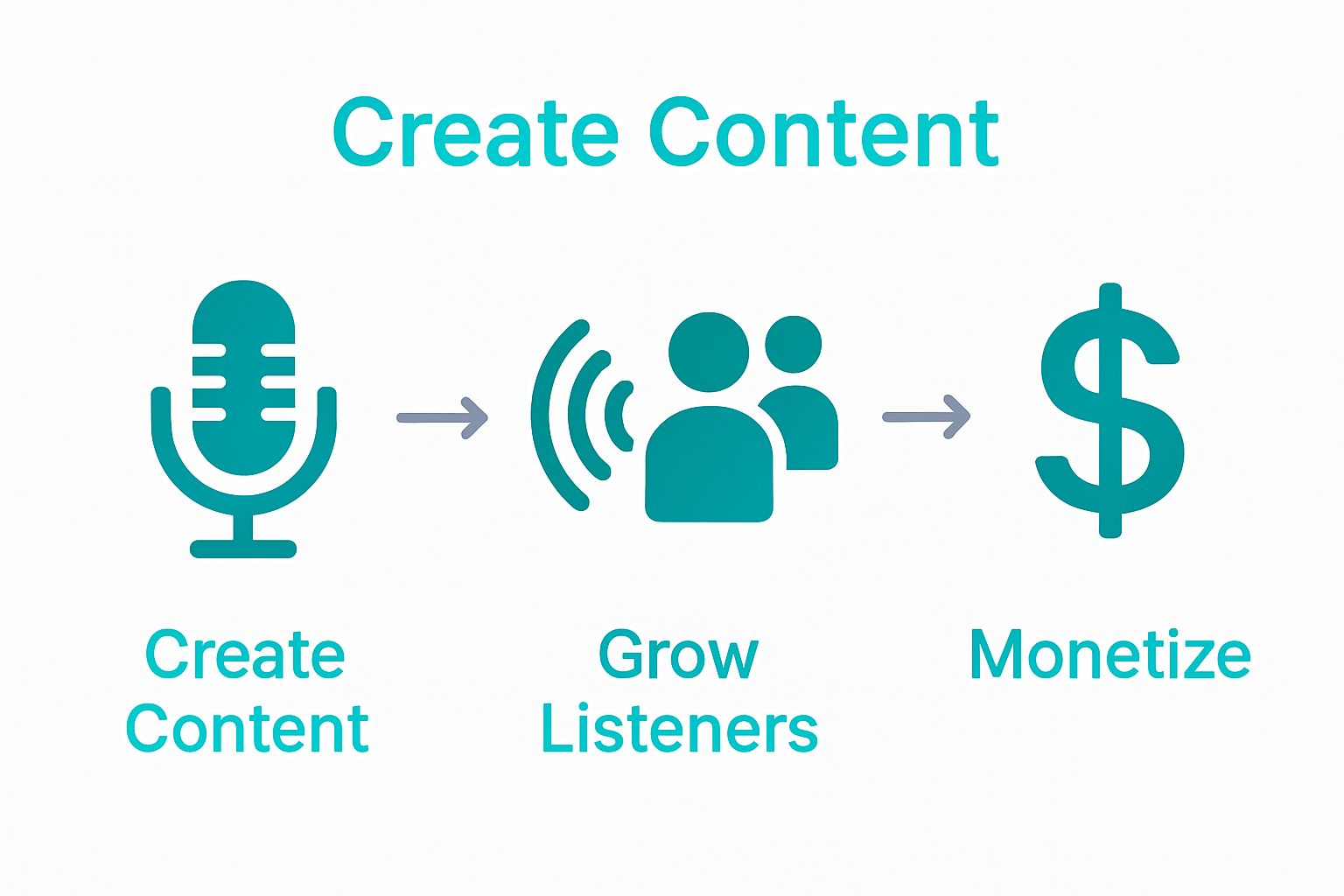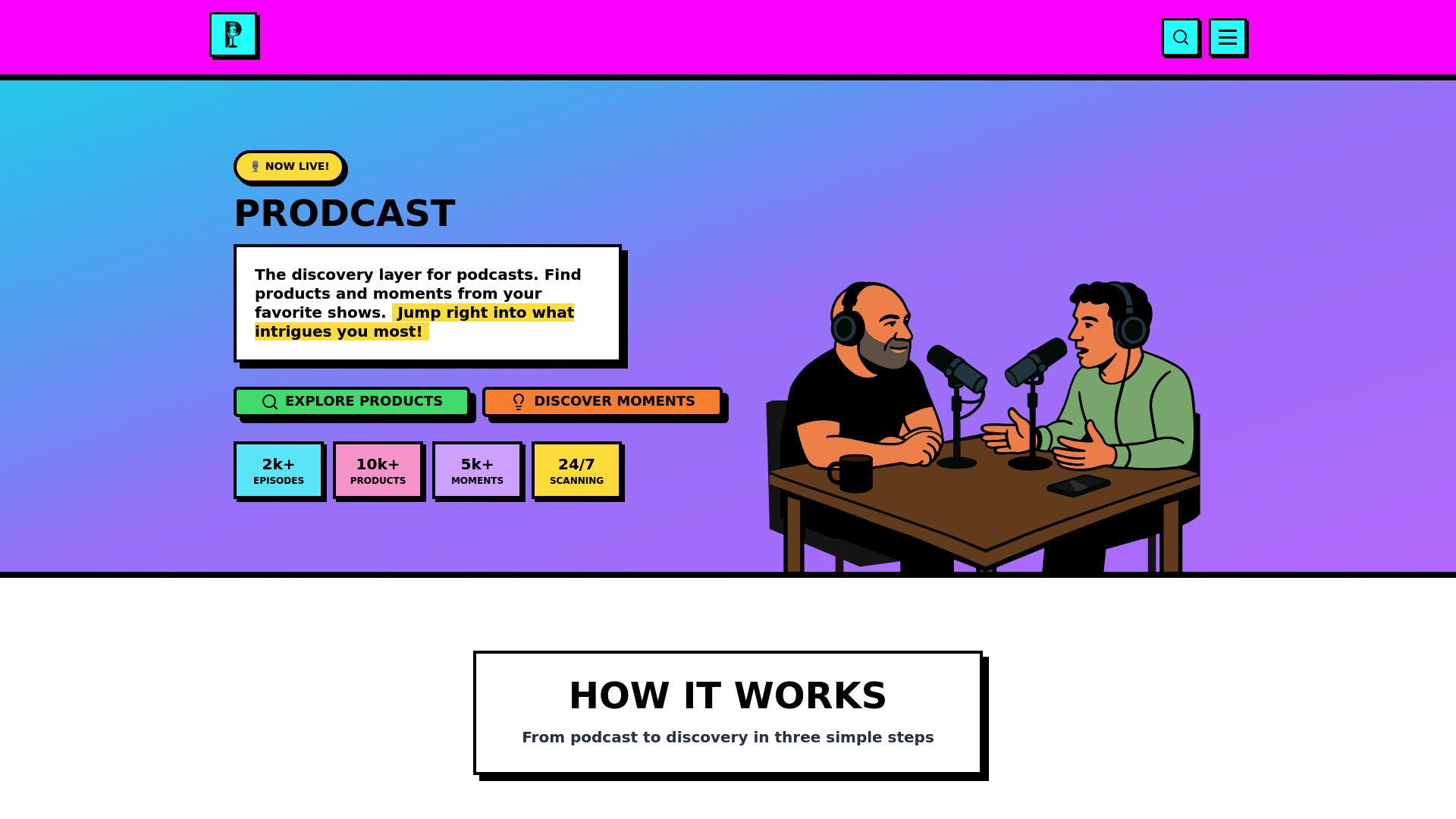CATEGORIES
How to Monetize Podcasts: A Step-by-Step Guide

Building a profitable podcast might sound like a dream reserved for social media stars. But around 62 percent of listeners say they are more likely to consider brands they hear about on podcasts. Most creators think success hinges on chasing downloads. What actually matters is how well you know your audience and the unique space your show claims. The real money follows podcasters who get specific, not those casting the widest net.
Table of Contents
- Step 1: Define Your Target Audience And Niche
- Step 2: Build Quality Content And Grow Your Listener Base
- Step 3: Explore And Implement Monetization Strategies
- Step 4: Set Up Analytics For Performance Tracking
- Step 5: Adjust Your Approach Based On Feedback
Quick Summary
| Key Point | Explanation |
|---|---|
| 1. Define your target audience clearly | Understand who your listeners are and what they seek from your podcast to create relevant content. |
| 2. Create high-quality, engaging content | Consistently produce exceptional episodes that provide value, ensuring listeners return and recommend your podcast. |
| 3. Implement sustainable monetization strategies | Utilize diverse revenue streams such as sponsorships, affiliate marketing, and premium content to generate income. |
| 4. Utilize analytics for informed decisions | Track key performance metrics to understand audience behavior and enhance both content and monetization strategies. |
| 5. Adapt based on listener feedback | Create systems to collect feedback and make strategic changes to improve content and grow listener engagement. |
Step 1: Define Your Target Audience and Niche
Successful podcast monetization starts with knowing exactly who will listen to your content and what unique value you provide. Understanding your target audience isn’t just a preliminary step - it’s the strategic foundation that determines how effectively you can transform your podcast into a profitable venture.
Begin by performing deep audience research that goes beyond basic demographics. Your ideal listener profile should include psychological insights, not just age and location. Consider their interests, professional background, challenges, and media consumption habits. For podcast creators, this means understanding not just who might listen, but why they would choose your specific podcast over countless alternatives.
Explore podcast audience demographics to refine your targeting strategy. Develop a detailed persona that represents your core listener. Are they professionals seeking industry insights? Entertainment seekers? Hobbyists wanting specialized knowledge? The more precisely you can describe this persona, the more effectively you can craft content and monetization strategies.
Narrowing your niche is equally critical. Generalist podcasts struggle to attract dedicated audiences and monetization opportunities. Instead, identify a specific segment where you can become an authoritative voice. This might mean focusing on a particular industry subset, a unique perspective, or a specialized topic that isn’t oversaturated.
Verify your niche’s potential by asking critical questions: Can you consistently produce engaging content in this area? Do potential listeners actively seek information about this topic? Are there existing monetization pathways like sponsorships, affiliate marketing, or consulting opportunities within this niche?
Research potential revenue streams specific to your chosen audience and niche. Some niches support premium memberships, while others work better with sponsorship models. Technical fields might attract high-value consulting opportunities, whereas entertainment podcasts could leverage merchandise or live event revenues.
Key verification indicators that you’ve successfully completed this step include:
Below is a checklist table to help verify you have completed the essential steps for defining your podcast’s audience and niche.
| Verification Item | Description |
|---|---|
| Ideal Listener Persona | Developed a detailed profile including interests, challenges, and motivations |
| Consistent Topics | Identified 3-5 specific topics you can reliably create content around |
| Monetization Strategies | Mapped revenue opportunities specific to your selected audience and niche |
| Market Research | Confirmed there is genuine audience interest in your chosen area |
| Flexibility in Approach | Prepared to refine your audience and niche as feedback is gathered |
- A crystal-clear description of your ideal listener persona
- Identified 3-5 specific topics you can consistently discuss
- Mapped potential monetization strategies unique to your niche
- Preliminary market research confirming audience interest
Remember, choosing your audience and niche is not a one-time decision but an evolving process. Stay flexible and be prepared to refine your approach as you gather more listener feedback and market insights.
Step 2: Build Quality Content and Grow Your Listener Base
Building a profitable podcast begins with creating consistently exceptional content that transforms casual listeners into dedicated fans. Quality isn’t just about production value - it’s about delivering genuine value that keeps your audience coming back and recommending your show to others.
Develop a robust content strategy that balances reliability with creativity. This means establishing a consistent publishing schedule while maintaining flexibility to explore topics that genuinely excite your audience. Aim for depth over quantity. One meticulously researched, engaging episode is far more valuable than multiple mediocre releases.
Boost your podcast audience growth by focusing on storytelling techniques that make your content memorable. Structure each episode with a clear narrative arc: introduce a compelling hook, build tension or curiosity, provide insights, and conclude with a meaningful takeaway. Your listeners should feel they’ve gained something substantial from every episode.
Invest in professional audio quality without breaking the bank. Basic equipment like a good USB microphone, free audio editing software, and a quiet recording space can dramatically improve your production standards. Learn basic sound editing to remove background noise, balance audio levels, and create a polished listening experience.
Cross-promote your content strategically. Leverage social media platforms, podcast communities, and relevant online forums to expand your reach. Engage with listeners through comments, create shareable snippets, and encourage audience interaction. Treat every listener interaction as an opportunity to build your community.
Network with other podcasters in your niche. Guest appearances, collaborative episodes, and mutual promotion can expose your content to broader audiences. These relationships often lead to unexpected opportunities and accelerated listener growth.
Key verification indicators that you’ve successfully built quality content include:
- Consistent episode release schedule
- Positive listener feedback and engagement
- Growing download and listener retention metrics
- Active community interaction across platforms
Remember that growing a podcast audience is a marathon, not a sprint. Stay patient, continuously improve your craft, and remain authentic to your original vision. Your unique voice and perspective are your most significant differentiators in a crowded podcasting landscape.
Step 3: Explore and Implement Monetization Strategies
Monetizing your podcast requires a strategic approach that balances listener experience with sustainable revenue generation. Multiple income streams are key to building a robust podcast business model. Your goal is to create complementary monetization channels that feel natural and provide genuine value to your audience.
Sponsorship and advertising represent the most traditional podcast revenue method. However, successful sponsorships demand more than just audience size. Brands want targeted, engaged listeners who trust your recommendation. Develop a media kit that showcases your audience demographics, engagement metrics, and unique value proposition. Practice creating authentic, seamless sponsor integrations that don’t disrupt your content’s flow.
Learn product launch strategies that can help you diversify your podcast income. Consider creating premium content tiers where dedicated listeners can access exclusive episodes, behind-the-scenes material, or deeper topic explorations. Platforms like Patreon make membership models straightforward, allowing fans to directly support your creative work.
Affiliate marketing offers another powerful monetization pathway. Recommend products or services genuinely relevant to your audience, using unique tracking links to earn commissions. The key is maintaining authenticity - only promote products you would personally use and believe provide real value. Your listeners trust your recommendations, so protect that relationship carefully.
Develop digital products that extend your podcast’s universe. This might include downloadable guides, online courses, or consulting services directly related to your podcast’s topic. These offerings create additional revenue while deepening your relationship with your most engaged listeners.
Consider live events, workshops, or speaking engagements as potential income sources. Your podcast establishes you as an expert in your niche, which can translate into paid opportunities beyond digital content. Conferences, corporate training, and industry events often seek knowledgeable speakers with proven audience engagement.
Key verification indicators that you’ve successfully implemented monetization strategies include:

- Multiple revenue streams established
- Clear, professional sponsorship materials
- Positive listener feedback on monetization approach
- Measurable income from podcast-related activities
Remember that monetization is a gradual process. Start with one or two strategies, measure their effectiveness, and continuously refine your approach. Your podcast’s unique voice and audience connection remain your most valuable asset in creating sustainable income.
The table below summarizes popular podcast monetization strategies with a brief description and their best-fit audiences or niches.
| Monetization Method | Description | Best For |
|---|---|---|
| Sponsorships & Ads | Partnering with brands to promote products within your episodes | Niche audiences, industry-specific shows |
| Affiliate Marketing | Earning a commission by recommending relevant products or services | Podcasts with actionable, product-relevant content |
| Premium Memberships | Offering bonus/exclusive content to paying subscribers | Highly engaged fanbases |
| Digital Products | Selling guides, courses, or tools related to podcast content | Educational, how-to, or technical topics |
| Live Events/Speaking | Hosting events, workshops, or paid speaking engagements | Authority-driven, community-focused podcasts |
Step 4: Set Up Analytics for Performance Tracking
Analytics transform podcast data from abstract numbers into strategic insights that drive monetization. Comprehensive performance tracking is your roadmap to understanding audience behavior and optimizing revenue potential. Without precise measurement, you’re essentially navigating your podcast business blindfolded.
Dive deep into podcast analytics by selecting robust tracking platforms that provide granular insights. Professional podcast hosting services like Libsyn, Buzzsprout, and Blubrry offer integrated analytics dashboards. These tools track critical metrics beyond simple download numbers, revealing listener engagement patterns, geographic distribution, device preferences, and episode retention rates.
Focus on key performance indicators that directly impact monetization potential. Download numbers represent your baseline reach, but deeper metrics tell a more nuanced story. Track average listening duration, subscriber growth rate, geographic listener distribution, and episode completion percentages. These indicators help you understand not just how many people hear your podcast, but how deeply they engage with your content.

Implement cross-platform tracking to get a comprehensive view of your podcast’s performance. Most hosting platforms provide embed codes and tracking links that work across Spotify, Apple Podcasts, Google Podcasts, and other major networks. By consolidating data from multiple sources, you’ll develop a more accurate understanding of your podcast’s true reach and audience demographics.
Establish a regular analytics review schedule. Set aside dedicated time each month to analyze your performance metrics, looking for trends, sudden changes, and potential opportunities for content or monetization optimization. Pay special attention to episodes that significantly overperform or underperform, as these provide valuable insights into what resonates with your audience.
Connect your analytics to your monetization strategy. Use listener data to refine sponsorship pitches, identify potential affiliate marketing opportunities, and develop targeted premium content. Brands and potential partners will be impressed by podcasters who can provide detailed, data-driven audience insights.
Key verification indicators that you’ve successfully implemented analytics tracking include:
- Consistent data collection across multiple platforms
- Monthly performance review process established
- Clear understanding of key listener demographics
- Actionable insights derived from performance metrics
Remember that analytics are a tool, not a goal. The objective is to use these insights to create better content, enhance listener experience, and ultimately build a more sustainable podcast business.
Step 5: Adjust your Approach Based on Feedback
Podcast success is an evolving journey that demands continuous adaptation. Feedback is the compass that guides your content and monetization strategy, transforming listener insights into actionable improvements. Your willingness to listen, analyze, and respond to audience input separates successful podcasters from those who remain stagnant.
Enhance your communication skills by creating multiple feedback channels. Establish dedicated platforms where listeners can share honest opinions - this might include podcast review sections, social media polls, email feedback forms, or dedicated community forums. The goal is to make providing feedback effortless and engaging.
According to podcast industry research, successful podcasters treat listener feedback as a strategic asset. Implement a systematic approach to collecting and processing audience input. Create a feedback tracking system where you categorize comments into actionable segments: content suggestions, technical improvements, monetization preferences, and audience experience observations.
Analyze feedback through multiple lenses. Quantitative metrics from your analytics platform provide objective data, while qualitative listener comments offer nuanced insights. Pay special attention to consistent themes across different feedback channels. Recurring suggestions are not complaints but roadmaps for improvement.
Be prepared to make strategic pivots based on audience input. This might involve adjusting episode length, experimenting with new segment formats, refining your monetization approach, or even repositioning your podcast’s core messaging. Flexibility is your greatest asset in maintaining audience engagement and growing your podcast’s revenue potential.
Develop a transparent feedback loop with your audience. When listeners provide suggestions that result in actual changes, acknowledge their contribution. Share how their input has shaped your podcast’s evolution. This approach transforms passive listeners into active community members who feel personally invested in your podcast’s success.
Key verification indicators that you’ve successfully implemented feedback strategies include:
- Established multiple feedback collection mechanisms
- Regular review and categorization of audience input
- Documented improvements based on listener suggestions
- Increased audience engagement and retention rates
Remember that feedback is a gift. Each comment represents a listener who cares enough about your content to share their perspective.
Here is a checklist to confirm you are effectively leveraging feedback in your podcast improvement process.
| Verification Item | Description |
|---|---|
| Multiple Feedback Channels | Established diverse ways for listeners to provide feedback |
| Regular Review Process | Routinely analyze and categorize audience feedback |
| Actionable Changes Implemented | Made clear improvements based on listener suggestions |
| Communicated Changes to Audience | Shared with listeners how their input has shaped podcast updates |
| Improved Engagement & Retention | Observed increased audience participation and loyalty |
Unlock Podcast Monetization With Smart AI Insights
Are you struggling to bridge the gap between creating quality content and earning real revenue from your podcast? This guide explained how vital it is to understand your audience, develop a niche, and implement analytics-driven monetization. But even the best strategies can hit a ceiling when it becomes too difficult to match listener interest with the perfect products or sponsorship opportunities.

Now is the time to turn every episode into a business opportunity. Prodcast uses advanced AI to scan your podcast episodes, pulling out exact product mentions and the big moments your audience connects with most. Whether you want to boost affiliate sales, provide instant Amazon shopping links, or become a vendor yourself, Prodcast transforms passive listening into actionable revenue. Ready to activate your audience and fuel your growth? Visit Prodcast to experience how our unique tools connect your content with commerce. Try it today to elevate your podcast income without guesswork.
Frequently Asked Questions
How can I define my target audience for monetizing my podcast?
To define your target audience, research listener demographics, interests, and motivations. Create a detailed listener persona that encapsulates who they are and why they would choose your podcast. Aim to refine this persona continuously as you gather more feedback.
What content strategy should I adopt to grow my podcast audience?
Adopt a strategy that prioritizes quality over quantity, focusing on creating consistently exceptional content. Release episodes on a regular schedule while remaining flexible enough to explore topics that resonate with your audience. Look for opportunities to engage with listeners and encourage them to return.
What are the main monetization strategies for podcasts?
The main monetization strategies include sponsorships, affiliate marketing, premium memberships, and selling digital products. Start small by implementing one strategy, like sponsorships, and expand to additional methods as you grow your audience and understand their preferences. Monitor which approaches yield better results over time.
How can I track my podcast’s performance effectively?
To track your podcast’s performance, establish a routine for analyzing key metrics such as download numbers, listener engagement, and episode retention rates. Use analytics dashboards from your podcast hosting platform to get a comprehensive view of audience behavior and regularly review this data to adapt your content and monetization strategies accordingly.
What should I do with listener feedback to improve my podcast?
Utilize listener feedback by creating channels for them to share their opinions and suggestions. Categorize this feedback into actionable insights and be open to making changes based on common themes. Regularly communicate back to your audience about how their input is shaping your podcast’s development to foster a sense of community.
How long does it typically take to see monetization results from my podcast?
Seeing results from monetization can take several months as you build your audience and implement strategies. Aim to evaluate your monetization efforts after six months, allowing enough time to understand what’s working and what needs adjustment for better performance.
Recommended
- How to Launch a Podcast for Listeners and Brands | Prodcast
- How to Increase Downloads: Boost Your Podcast Reach | Prodcast
- How to Start an Affiliate Blog That Earns Money in 2025 | Prodcast
- Understanding Podcast Content Marketing for Brands | Prodcast
- How to Repurpose Content for Maximum Reach and Impact